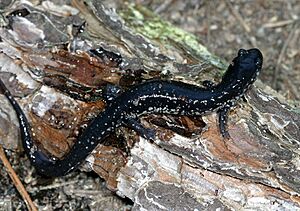White-spotted slimy salamander facts for kids
Quick facts for kids White-spotted slimy salamander |
|
|---|---|
 |
|
| Conservation status | |
| Scientific classification | |
| Genus: |
Plethodon
|
| Species: |
cylindraceus
|
The white-spotted slimy salamander (Plethodon cylindraceus) is a type of salamander. It lives only in the Eastern United States. This means it is found nowhere else in the world. It is one of 55 kinds in its group, called Plethodon. This salamander was one of the first from its group to be studied and named.
What it's Like
The white-spotted slimy salamander has a special body. Unlike most animals, it does not have lungs. This means it breathes through its skin. Its skin helps it take in oxygen and release carbon dioxide. It also helps the salamander absorb water.
These salamanders like to live in cool, shady places. They are often found under logs and piles of leaves. They prefer forests with hardwood trees. They also like wooded areas near rivers. On wet nights, they often come out to look for food.
What it Eats
This salamander mainly eats small insects and other tiny creatures. Its diet includes ants, centipedes, and springtails. It also eats crickets, millipedes, and slugs. Snout-beetles and earthworms are also on its menu.
How it Stays Safe
The white-spotted slimy salamander has ways to protect itself from predators. When it feels threatened, it can release a sticky, bad-tasting substance. This substance comes from special glands in its skin. It helps to scare away animals that might try to eat it.
Another way it stays safe is by freezing still. If something touches it, the salamander will stop moving. This makes it harder for predators to see or catch it. Common predators include garter snakes, copperhead snakes, and birds.
Life Cycle and Reproduction
Most salamanders lay their eggs in water. But the white-spotted slimy salamander is different. It lays its eggs on land. The eggs develop directly into tiny salamanders. This means they skip the tadpole-like stage that many amphibians have. Because of this, these salamanders do not need to live near water to have babies.
Sometimes, these salamanders can get tiny mites on them. These mites are called Trombicula mites. They are a common type of parasite for this salamander and other similar ones.
Where it Lives
This salamander is found in several parts of Virginia and North Carolina. It lives in the Virginia Piedmont and Blue Ridge areas. It also lives west to the French Broad River. You can find it south to the northern Piedmont of South Carolina.
It also lives in parts of the Appalachian Mountains. These areas include the Valley and Ridge region of western Virginia. It is also found in a small part of eastern West Virginia. A small number also live in the Atlantic Coastal Plain of eastern Virginia.
The places where these salamanders live are called their natural habitat. Their homes are sometimes threatened. This happens when their habitat is lost or destroyed.


